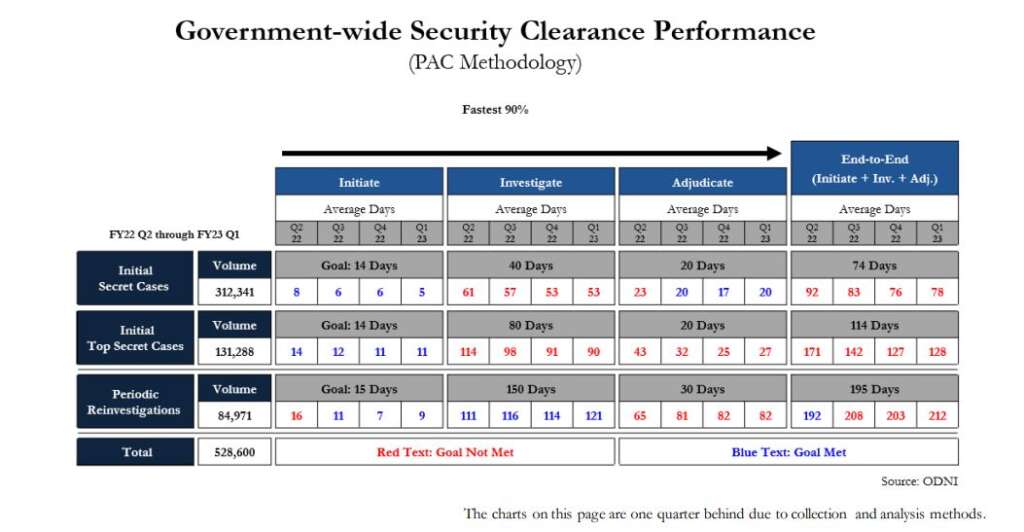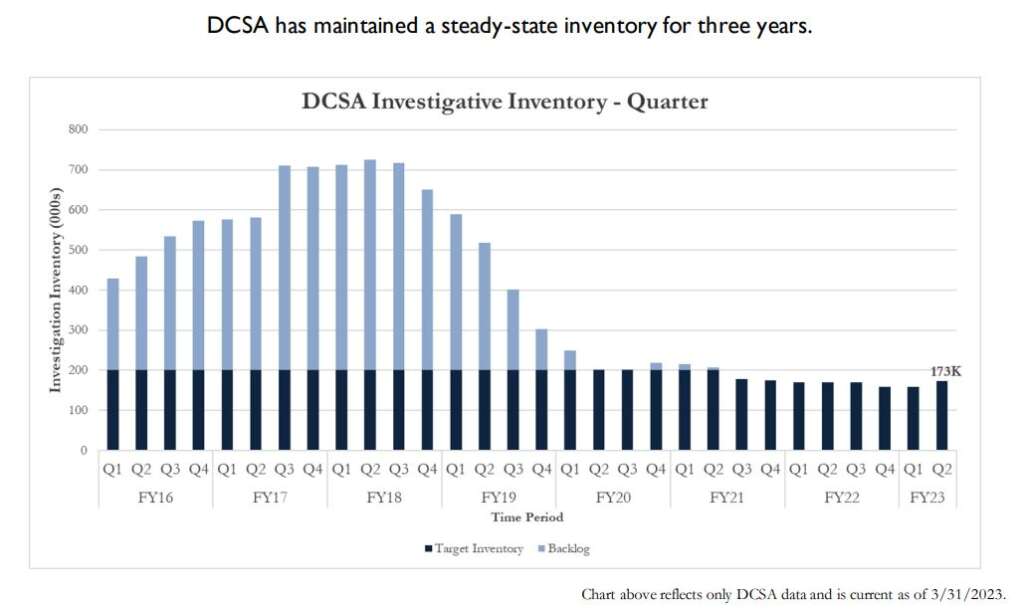Congress, Biden administration continue push to reduce security clearance timeline
OPM and DCSA are making policy and technology changes are part of the implementation of the Trusted Workforce 2.0.
In the coming months, agencies will receive guidance outlining updated goals and aspirational targets to reduce the time to vet employees for security clearances and to make the initial employment determination.
These new metrics are part of how the Office of Director for National Intelligence and the Office of Personnel Management are moving the government further into the Trusted Workforce 2.0 initiative.
“Significant actions will be required to achieve various targets, and they will be dependent on capabilities that are not yet in place,” the administration wrote in the latest update to the President’s Management Agenda released earlier this month. “As capabilities are put in place and the TW 2.0 model is refined, the aspirational targets will be refined. The new targets, notionally to begin in fiscal 2028, represent a significant improvement in the speed of delivering talent to the mission.”
At an April hearing, OPM and Office of Management and Budget leaders detailed the initial thinking for these new goals: For end-to-end vetting are 25 days for public trust eligibility; 40 days for secret-level security clearance and high-risk public trust eligibility; and 75 days for top-secret eligibility.
The current goals are 75 days for secret-level eligibility and 114 days for top-secret, while there isn’t a statutory goal for lower tier, public trust positions.

The quarterly update comes as Congress also is pushing the administration to establish and publish in the Federal Register new timeliness performance standards for processing personnel vetting trust determinations. The Senate included this and several other Trusted Workforce 2.0 provisions in the Intelligence Authorization Act for Fiscal Year 2024, passed by the Select Committee on Intelligence on June 14.
The House introduced a companion bill on June 7, but it hasn’t marked it up or held any hearings about the legislation yet.
The Senate’s version also includes several other reporting requirements, both from ODNI and OPM, as well as from the Government Accountability Office.
While the Intelligence Authorization Act makes its way through Congress, the agencies overseeing the implementation of Trusted Workforce 2.0, OPM, the Defense Counterintelligence and Security Agency (DCSA) and the Office of Management and Budget, say they continue to improve the security clearance process and have all but eliminated the backlog of cases.
“The first phase of the work really focused on getting the backlog and the timeliness under control. We reduced that from 750,000 cases to now it’s hovering around 157,000 cases. After that, we started turning our attention to new ways to do the work that involves rewriting and recrafting the majority of the policies,” said Matt Eanes, the director of the Performance Accountability Council Program Management Office at OPM, at a recent event sponsored by the Intelligence and National Security Alliance, an excerpt of it played on Ask the CIO. “We quickly turned our attention to getting folks in rolled into continuous vetting. That was focused on just the national security sensitive population. So all those individuals with top secret and secret clearances, which is about 4.4 million folks, are now enrolled in continuous vetting. It was largely done pretty seamlessly, not completely seamlessly.”

Now that the inventory of security clearance cases is more manageable, Eanes said the focus over the next few years will be to continue to expand the continuous vetting program and transition to the National Background Investigation System (NBIS).
NBIS is made up of modern software and hardware to help manage the security clearance process. DCSA took over these technologies and processes from OPM in 2019.
“If the focus of last year was getting everyone into continuous vetting for the national security population, the focus of this year is beginning our transition into NBIS, and in particular the transfer from e-Quip to E-App,” Eanes said. “The focus for next year will be moving the continuous vetting model into the non-sensitive public trust population. The other half of our population is the non-sensitive population so they’ll begin their journey in 2024 and in 2025, you’re going to start to see all the new products and the new model.”
The transition to e-App from e-Quip has been going well, said Jeffrey Smith, the program executive officer for the NBIS in DCSA.
He said 83 of 103 agencies are using e-App and the three pilot agencies have submitted about 56,000 cases through the system. Smith added DCSA’s goal is to get all agencies using E-App by the fourth quarter of fiscal 2023.
“We’ve been pressure testing the system since last March. We started with one form iteratively brought one form online, the SF-86. Over the year, we brought on all four forms. We’ve then added prefill capabilities. So all of those muscle movements for the initiation, review and authorize for case initiation are fully active right now,” Smith said.
Operation Popcorn heating up
On the industry side, Smith said Operation Popcorn is well underway, following a similar path as the federal agencies did to begin using e-App.
Smith said the goal is to bring more vendors into e-App starting in October.
“Additional phases and capability will be bought on board deliberately for NBIS, such as the Defense Information System for Security (DISS) transition,” Smith said. “But just so you hear it for me, DISS is expected will still be your foundational system as you start to cut across and start to use a-App versus e-Quip. So nothing is going to change initially. And in very, very short order, as we continue to mature, we will activate other elements of the system.”
There’s about a million defense contractors or national security contractors that are enrolled in that continuous vetting program.
The e-App system will provide users with automated error checking, a more user friendly experience to reduce the burden on the employee and advanced data sharing and checking such as zip codes.
“We’re seeing a lot of good results in the feedback on how that’s helping us facilitate faster processing of an individual applicant to the decision,” Smith said.
Along with the technology changes, DCSA is revamping its policies too, specifically around initial vetting concepts and interim determinations.
SF-86 forms going away
Heather Green, the deputy assistant director for vetting risk operations and consolidated adjudicated services at DCSA, said currently it takes about seven days to issue interim determinations and the agency does about 100,000 a year.
“We are looking at how we can make that even better. We’re looking to bolster the timeliness of those interim determinations with more data to inform quality, risk based decision,” Green said. “We are piloting several efforts in this area. Specifically, we have ongoing pilots, something called high yield check pilot or also known as rapid vetting pilot. The goal of this is to obtain as much high value information upfront rapidly as possible to inform that risk-based decision. We’re making some strides and some headway in that perspective.”
Next on DCSA’s to-do list is to move away from SF-86 forms. Green said the goal is to automate the questions and answers through a self-reporting service as part of obtaining real-time data.
“We don’t want to wait five years to find out someone has moved or someone has information to report to us. We want it to be real time so that we can update our continuous vetting automated record checks so that we can make sure we have a robust quality program,” she said. “We are also looking to begin using conditionals determinations and continuous vetting together as a risk management approach. For industry, we are already doing this with our military and civilian population. So we are looking to move towards using this as an option with our industry population, hopefully this summer we will have more communication, more partnership to talk about how exactly that is going to look.”
She added the goal is let federal adjudicators grant eligibility more quickly based on a risk assessment.
A conditional determination may mean the adjudicator would request additional information or initiate a different review at a later date, but the person would have their conditional approval.
“We’re estimating that there’ll be several hundred individuals that will not go through due process. We can monitor them through continuous vetting and then continue to work together to mitigate that risk,” Green said.
Copyright © 2025 Federal News Network. All rights reserved. This website is not intended for users located within the European Economic Area.
Jason Miller is executive editor of Federal News Network and directs news coverage on the people, policy and programs of the federal government.
Follow @jmillerWFED






